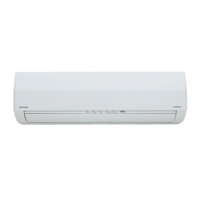25 EN
FRANÇAISDEUTSCHSVENSKAРУССКИЙ ЯЗЫКSUOMIDANSKNORSK ENGLISH
TROUBLESHOOTING
CAUTION
If any of the following conditions occur, stop the air conditioner immediately, turn off the main power switch and contact the
dealer.
• The indicators flash at short intervals (5 Hz). Reset the circuit breaker 2 to 3 minutes after the power main switch is turned off.
Despite the resetting operation, the indicators still continue turning on and off.
• The main power fuse often blows, or the circuit breaker is often activated.
• Foreign matter or water has fallen inside the air conditioner.
• Any other unusual conditions are observed.
Before asking for servicing or repairs, check the following points.
Recheck
Inoperative
• The power main switch is turned off.
• The circuit breaker is activated to cut off the power supply.
• The main power fuse has blown.
• The electric current has stopped.
• The batteries in the remote controller used up.
• The ON timer is set.
• As a protective mechanism for the air conditioner, it does not operate for 3 minutes
immediately after restarting operation or turning on the main power.
Poor cooling or heating performance
• The air inlet or outlet of the outdoor unit is blocked.
• Doors or windows are opened.
• The air filter is clogged with dust.
• The louver is not at the correct position.
• The fan speed is set to low.
• The air conditioner is set to the DRY or SLEEP MODE.
• The temperature setting is too high (during cooling operation).
• The temperature setting is too low (during heating operation).
These are not defects.
Condensation forms on the back of the indoor unit.
• Condensation on the back of the indoor unit is automatically collected and drained out.
Indoor unit or outdoor unit makes a strange noise.
• When the temperature changes sharply, the indoor or outdoor unit may make a strange
noise (such as a tit-tack noise or flowing noise) because of the expansion/contraction of
parts or change in refrigerant flow.
The room air smells.
A bad odor comes from the air conditioner.
• Smells absorbed in the wall, carpet, furniture, clothing, or furs are coming out.
• During PURE operation, a small amount of ozone is produced, and you might notice the
smell.
A1YPGTU/CPWCNA'0HO2CIG9GFPGUFC[,CPWCT[2/

